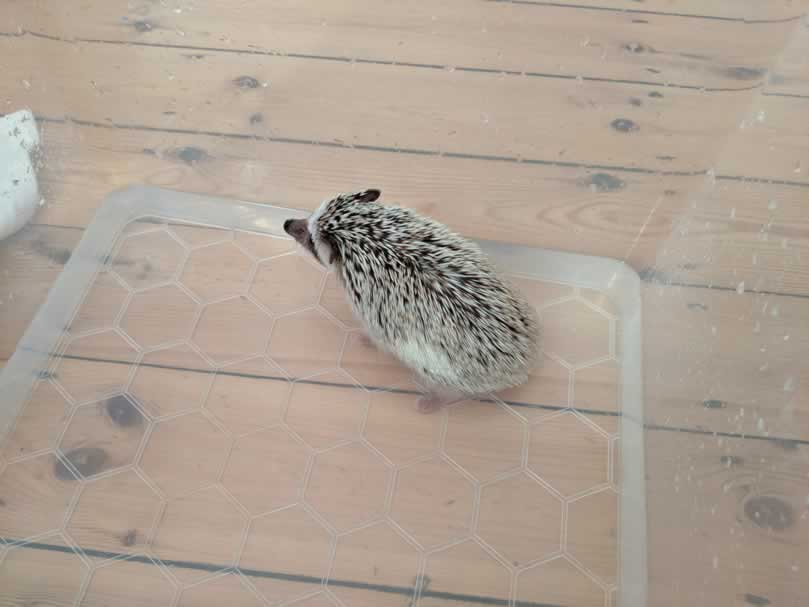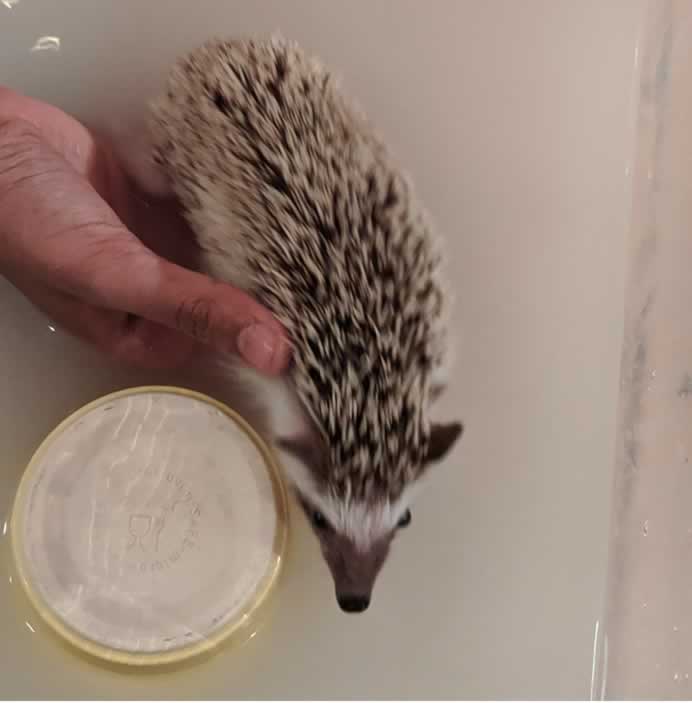
Hedgehog skin can become dry and flaky if it is not cared for properly. Dry skin can be painful for hedgehogs and lead to cracks and infections.
11 hedgehog skincare tips? Hedgehogs skincare is important as they can easily get dry skin. Causing their skin to crack and become painful, leading to potential infection. Dry skin can be minimized by following 11 tips below:
- Avoid bathing hedgehogs too much
- Use an oat-based wash
- Be careful using washes and oils
- Dry hedgehogs carefully
- Keep hedgehogs warm as heat can dry skin
- Avoid the cold as it can dry skin too
- Use good oils
- Avoid bad oils
- Don’t use scented washes
- Check for mites as they can cause dry skin
- Check for fungal and bacterial infections
Dry skin will have tell-tale signs, a white dandruffy like powder on the limbs of the hedgehog and whilst a few flakes may not be an issue, if left untreated this could lead to cracked skin, potentially resulting in more serious health conditions like infections.
The following 11 tips can help you look after your hedgehog’s skin.
1. Avoid bathing hedgehogs too much
We give our hedgehog a bath every fortnight as doing so more regularly could increase the likelihood of his skin drying out. It’s also important to note we keep his cage clean by vacuuming out his droppings every night and changing his running wheel and bedding on a regular basis, limiting him to becoming too dirty.

If we do have to break the bathing cycle and give him an extra bath, we tend to do it only to make sure the poop on his legs and feet is removed. Because hedgehogs poop and walk straight through their poop, they inevitably pick it up on their feet.
The poop hardens very quickly so we sometimes give him just a foot bath by putting in a small amount of water and letting him walk through it. This softens the poop and we can gently rub it off.
The bath time is generally very short when we do these emergency type baths, as we’re not looking to give our hedgehog a thorough bath but just a quick clean.
Fur can also get matted with bits of poop especially as hedgehogs wander around the cage at night with fresh poop easily being picked and quickly dry into their fur.
Again, we found that when we did the feet wash, this was also good enough to get the poop out of fur by dissolving it in the water as our hedgehog’s belly would also rub along the surface of the water.
2. Use an oat-based wash
Some people when bathing their hedgehogs use an Aveeno body wash, as this contains some colloidal oats, which in essence are very finely grained oat (oatmeal) particles.
Oats are generally thought to provide some moisturizing benefits to dry skin and such body washes, creams and moisturizers containing colloidal oats are used by eczema suffers to limit their skin from drying out during washing.
It makes sense to consider these for washing your hedgehog but make sure none of the other ingredients is damaging to the hedgehog.

Alternatively, we’ve also used an old sock in which we put oats into and soak in the water. We use natural oats with no additional ingredients (some oats can have skimmed milk added which could exacerbate a hedgehogs lactose intolerance) just in case the hedgehog drinks the bathwater.
3. Be careful using washes and oils
I’ve noticed on many occasions when giving our hedgehog a bath, he tends to drink the water at the start of the bath, so it’s imperative for us to make sure whatever we add to his bathwater isn’t toxic to him.
Ironically after he’s pooped in the bathwater, he stops drinking the water. We tend to not add anything to the water for a preliminary wash, where we know he’ll drink the water and then he’ll have a good poop in the water.
Once he’s finished doing his business, we’ll change the water and in the freshwater, we’ll add the wash albeit an old sock full of oats but it could easily be a commercial wash.
4. Dry hedgehogs carefully
Once you’ve given you’re hedgehog a bath, they need to be kept warm whilst you dry them as they are extremely vulnerable to any cold at this time.
My daughter wraps him in a towel as soon as she takes him out of his bath and brings him close to her body as she dries him with the towel without opening up the towel and bearing him to the elements.
She makes sure he’s well dry and not wet before she puts him back into his cage and he wanders off to lie on his heat mat, further keeping him warm. We don’t leave him exposed to the air without at least being covered, so may if we have to do other things, put him in his pouch which is well insulated.
5. Keep hedgehogs warm as heat can dry skin
Your hedgehogs environment can play a major part in their skin symptoms, if there is a lack of humidity in the air, this can lead to dry skin. The dry warm air can sap away moisture in their skin and lead to the skin drying out.
We have central heating in our house, consisting of water heated radiators throughout our house. I know some friends who leave their heating consistently on at a high temperature and when we go and visit the dryness of the air, it makes you thirsty and for me, it makes me itchy, because it dries my skin.
It’s vital with any heating it’s not left on for prolonged periods with a high temperature which will simply result in any moisture in the air being depleted and making it highly likely your hedgehog’s skin will become dehydrated.
We regulate the temperature in our house to come on in the morning for a few hours and then in the evening for a few hours more. This is ‘getting rid of the chill’ as my wife calls it and it seems to do the trick in keeping the average temperature warm enough for all of us including our hedgehog.
If it does feel to dry in your house, you could try to spray water into the air just to try to increase the humidity. We’ve done this on many occasions when the temperature outside has made the house a lot hotter than normal.
6. Avoid the cold as it can dry skin too
Just as the heat can affect the skin by drying it out, cold can also do the same. It’s important to make sure there are no drafts at the hedgehog level and this can be done using a candle.
Simply take the candle around the outside of the cage (make sure your hedgehog is safely in another room when doing this) and if the flame flickers, this can be a sign of a draft.
This is a good method of finding drafts at the hedgehog level, as we may not feel the cold around our feet near their cage because of wearing shoes and socks but they will definitely feel any cold drafts.
7. Use good oils
Our vet did recommend adding some Vitamin E oil or Flaxseed oil to the final part of the bath cycle that is when the waters clean after any poop or wee soiled water has been removed.
We personally haven’t tried adding any Vitamin E or any Flaxseed oil to the water as yet, so would suggest anyone wishing to try this, to do so in small amounts first to see if there is any risk and also any perceived benefit or not.
8. Avoid bad oils
Olive oil seems to be also touted as a good moisturizer for hedgehogs but I’ve also read there is a problem with olive oils and it’s supposed moisturizing ability. In humans at least, Olive oil has caused a slight reddening when applied[1].
Olive oils[2] balance of oleic and linoleic oil is low and this is considered to be very poor leading to skin damage. Oils with a higher ration of linoleic acid to oleic acid are considered better for moisturizing but again, due diligence is required to make sure the oils used are safe for hedgehogs.
9. Don’t use scented washes
Be careful using other pet products to clean your hedgehog as some of these may be scented and lead to distress in your hedgehog from the smell. A product designed for one type of animal may not necessarily be safe enough for another type of animal.
This also holds true for any other scented product, such as oils, moisturizers, and creams. It’s important to remember what may be good for you might not be good for your hedgehog.
10. Check for mites as they can cause dry skin
Mites have also been touted as another cause of dry skin and symptoms of having mites include your hedgehog scratching too much, having quill (spines) loss leading to some bald patches. If you suspect your hedgehog may have mites, you should take them to your vet for a test for mites.
A word of warning on the treatment for mites, many people on the hedgehog related forums have suggested not to let your vet use ivermectin as mite eradication medicine, as they believe ivermectin is toxic and recommend using alternative medicine. I think if we were in that situation, we’d also ask for an alternative.
11. Check for fungal and bacterial infections
Fungus and bacterial infections can be another cause of dry skin and these can be easily treated using antibiotics. Again you’d have to seek medical advice for your hedgehog from your vet on the course of treatment.
We don’t take our hedgehog out into our garden, because I am worried about him getting a fungal, bacterial infection or getting struck with mites.
Conclusion
Making sure your hedgehogs skin doesn’t dry out and crack is essential and these tips can help immensely. For more information on caring about hedgehogs, check out my 10 Hedgehog Care Tips article.
Related Questions
How do you treat dry skin on hedgehogs? Make sure you’re not bathing them too much and stick to a two-week gap between baths. Use an oat-based wash as this is believed to provide moisturizing effects,
Can I put olive oil on my hedgehog? Research has shown in humans at least olive oil isn’t a good choice for moisturizing, so the same could apply to hedgehogs as it could make their dry skin worse.
[2] Moisturizers for skin diseases new insights

